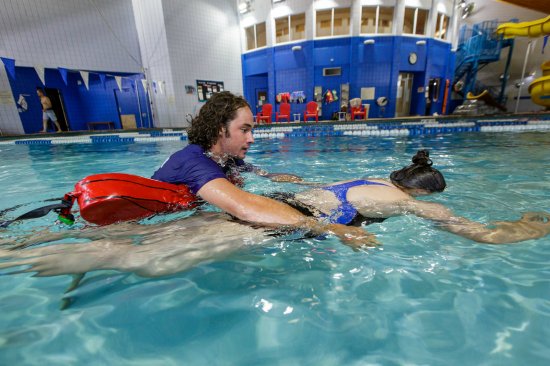Breckenridge Recreation Center
Breckenridge, Colo.
Category: Training
Highlights
• As the program has grown, skill drills now are performed four to six times a week.
• Special documentation for the drills, called Skill Review Sheets, includes performance data that can be referenced for annual employee reviews.
• Peer-to-Peer Observation sheets provide the opportunity for coworker feedback.
• As an illustration of the training's effectiveness, two Breckenridge lifeguards took the top spots in Aquatics International’s annual Summer Lifeguard Challenge.
The Town of Breckenridge Recreation Center had a hard time hiring skilled lifeguards for the facility’s Pool and Aquatics Area. A lack of basic skills in the new hires made it tough to train for the season.
“We were seeing frustration during in-service training from the [lifeguard instructors], because our staff was not getting it,” says Carmen Brashier, aquatics coordinator for the center.
“We were struggling to get through a full scenario without needing to stop and correct,” she says. “During emergency responses, the aquatic leads always had to take over and give step-by-step instructions to the guards assisting.”

From adversity to strength
From this frustration arose the need to implement skill drills, from rescue breathing and CPR to “Big Eye” (scanning the water) and “Vigilant Voice” (verbalized observations).
For each drill, aquatics staff created a Skill Review Sheet for lifeguards, listing criteria and expectations. To track progress, forms are annotated with information about the trainer and lifeguards, as well as drill data such as trainee response times. The forms are kept in employees’ personnel files and can be used for annual reviews.
The program started small, with skill drills based on mistakes witnessed during in-service. As the program grew, drills were added. Now performed four to six times a week, they include rescuer, backboarding, primary assessment, treating for shock, checking for breathing, taking pulse and monitoring the victim. First aid is being added to the rotation.
Brashier’s team also developed Peer-to-Peer Observation sheets to help staff provide each other with constructive feedback. To add an element of realism, in 2019 the facility purchased a Rescue Timmy doll — a full-body pediatric water rescue training mannikin.

Success story
“What is special about our program is the growth we are seeing in our lifeguards,” says Brashier.
Guards who previously struggled with extractions or detecting a pulse not only have more confidence but even look forward to training. “They can perform a rescue from start to finish and are asking fewer questions,” Brashier says. “It is exciting to walk into the Aquatic area and see staff training or asking about when the next drill is going to be.”
Faster response times and increased competence are reflected in their skill review forms, she said.
As proof of the program’s effectiveness, Breckenridge lifeguards Bailey Baldwin and Josh Groth recently won first and second place in two of Aquatics International’s 2019 Summer Lifeguard Challenges.
Brashier credits the achievements to the three full-time aquatic leads: John Russell, Brady Stevens and Lauren Barends.
“They do the work every day with staff,” she says. “I just provided [direction and] encouragement along the way…“
